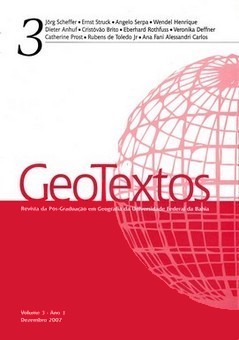REGIONAL DEVELOPMENT WITHIN THE RUHR DISTRICT – FROM THE FORMALLY CENTRE OF THE COAL AND STEAL INDUSTRY TO A CENTRE OF TERTIARY SERVICES
do distrito de carvão a região de prestação de serviços
DOI:
https://doi.org/10.9771/1984-5537geo.v3i0.3046Keywords:
Regional development, Economic and social structural change, Heavy industry sectors, Service sector, Ruhr districtAbstract
Regional development within the Ruhr district – from the formally centre of the coal and steel industry to a centre of tertiary services. The Ruhrgebiet (Ruhr district) is an urban agglomeration in the western part of Germany with a population of approximately 5.3 Million, covering an area of 4.435 km². It’s part of the metropolitan area of Rhine-Ruhr with more than 10 Million inhabitants living in an area of about 10.000 km².The black coal resources, deposited during the carboniferous area form the natural backbone for the development of the largest region of coal, iron, and steel industry in Europe. The economy of the Ruhrgebiet was unidirectional dominated for more than 150 years by four heavy industry sectors, black coal, steel, chemical industry and energy production. But later, when petroleum and natural gas and cheaper imported black coal conquered the German market and, as well, steel could be produced at a reduced rate elsewhere in the world the booming producing industry quasi collapsed. Thus, the Region is characterized by an above average unemployment since the mid 70ies. More than 50% of the 1 Million jobs in the region were lost, while only 300.000 new jobs could be added within the service sector between 1980 and 2002. The economic and social structural change within the Ruhr district is primarily based on the expansion of services like advertisement, science, development, transport logistics, consulting, and design. But also the cultural and tourist branches are characterized by growing figures. The BIP, produced within the Ruhrgebiet, is about 26% of the BIP of North-Rhine-Westphalia or 6% of Germany’s BIP. In comparison, the metropolitan area of São Paulo produces 17% of the national BIP of Brazil.Downloads
Downloads
Published
How to Cite
Issue
Section
License
Autores que publicam nesta revista concordam com os seguintes termos:
Autores mantém os direitos autorais e concedem à revista o direito de primeira publicação, com o artigo simultaneamente licenciado sob a Licença Creative Commons Creative Commons CC BY que permite o compartilhamento do trabalho com reconhecimento da autoria e publicação inicial nesta revista. Esta licença permite que outros distribuam, remixem, adaptem e criem a partir do seu trabalho, mesmo para fins comerciais, desde que lhe atribuam o devido crédito pela criação original. É a licença mais flexível de todas as licenças disponíveis. É recomendada para maximizar a disseminação e uso dos materiais licenciados. Ver o resumo da licença em: https://creativecommons.org/licenses/by/4.0/ Ver o texto legal da licença em: https://creativecommons.org/licenses/by/4.0/ Consulte o site do Creative Commons: https://creativecommons.org/licenses/?lang=pt
Autores têm autorização para assumir contratos adicionais separadamente, para distribuição não-exclusiva da versão do trabalho publicada nesta revista (ex.: publicar em repositório institucional ou como capítulo de livro), com reconhecimento de autoria e publicação inicial nesta revista.
Autores têm permissão e são estimulados a publicar e distribuir seu trabalho online (ex.: em repositórios institucionais ou na sua página pessoal) a qualquer ponto antes ou durante o processo editorial, já que isso pode gerar alterações produtivas, bem como aumentar o impacto e a citação do trabalho publicado (Veja O Efeito do Acesso Livre).






